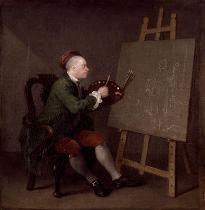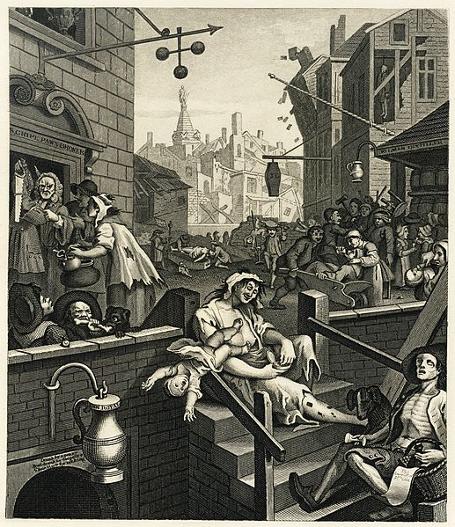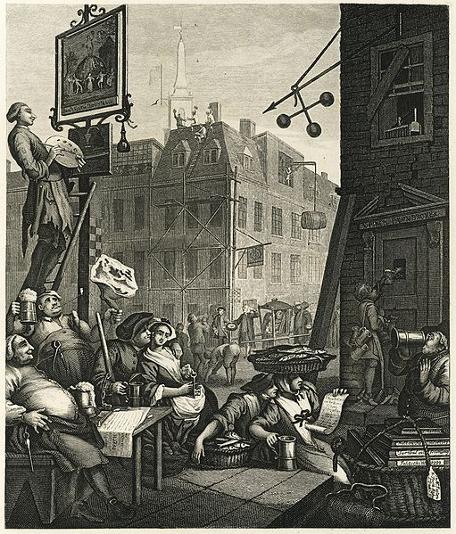

GIN LANE
--------------------------------------------------------------------------

BEER STREET
-----------------------------------------------------------------------
The pamphlet seller in the foreground ( said to be an ex soldier ) is close to starvation whilst the black dog is desperate meat. Is he ready to pounce when he expires and the opportunity arises? To the left of this a young boy and dog both close to starvation fight pathetically over the spoils of a bone.
The overall message is one of chaos, despair, and hapless addiction, powerfully conveyed.
-------------------------------------------------------------------------------------
BEER STREET
By comparison Beer street was designed to work on a different level. Again you initially focus on the figures in the foreground but in the background events also unfold.
There is an overall calmness about the piece and a sense of camaraderie, jollity and goodwill.
In contrast to Gin Lane the pawnbroker here, to the right, is in trouble. So far behind is he with rent (due to lack of business) that he refuses to open his door and accepts a mug of beer through a hatch. His sign is in disrepair as is the building.
There is good humour and contentment with the figures on the left, possibly a Butcher or Drayman enjoying their beer whilst taking a break, and the Cooper holds a tankard of ale and a leg of beef aloft - two statements designed to enforce his 'Englishness'.
In the background on the right the sedan chair halts under the weight of the buxom lady within whilst its carriers take a well earned rest to imbibe. The workers repairing the roof on' the 'Sun' Inn'pub toast the Master Tailor, on what is the Kings birthday.
The ladies to the right are cuddled as part of flirtatious and natural affection, no sense of entrapment or prostitution here. One is a lady fish seller who sings along with a companion 'The Ballad of Herring Fishery' whilst her overflowing basket a testament to the industries revival.
What Hogarth wanted to enforce is that ale, in measured intake, goes hand in hand with productivity, and also at the end of a days toil, a reward. It had a beneficial role to play both in a physical and emotional sense.
-------------------------------------------------------------------------------------------------
EFFECTS AND REFORM
Once completed Hogarth sold prints of both Gin lane and Beer street from his studio in London for 1s a piece, and it has often been said that this would have simply put them out of reach of the very class he was trying to reach. Whilst this may be true the prints would no doubt have been seen by the working classes displayed either in shops or reproduced in newspapers, and they certainly would have been aware of them by word of mouth.
More to the point is that the working classes had no political say over policy or reform during this time, and it was the middle or upper classes, those who could make real change who needed to be galvanized into taking action. The reward for his efforts was to see the Gin Act of 1751 finally take effect.
Both works offer a remarkable insight into a time when visual imagery crossed every class divide to bring around true social reform. Something Hogarth must have been tremendously proud of, and the nation, eternally grateful.
And Ale would forever be associated with the Mother country...
---------------------------------------------------------------------------------------------------------------------------